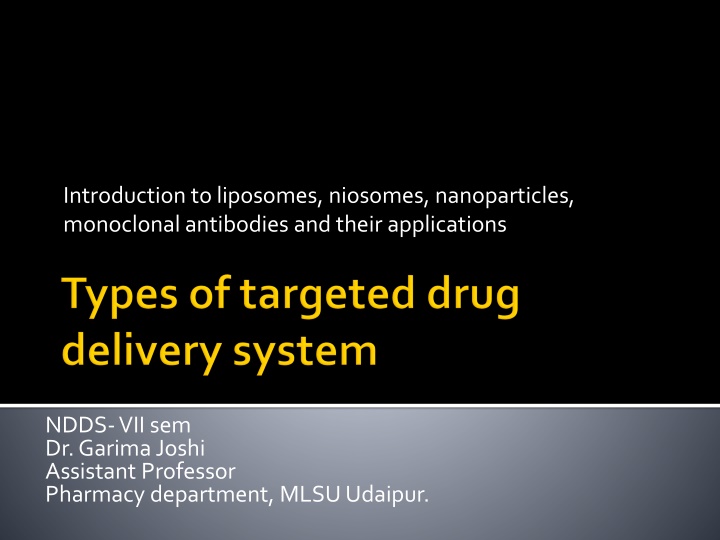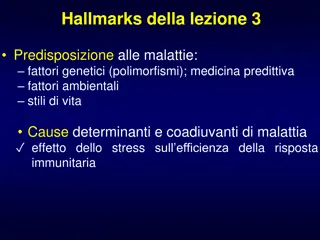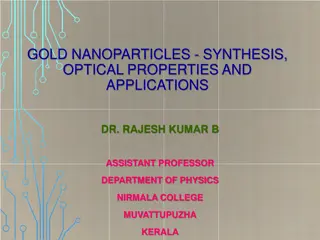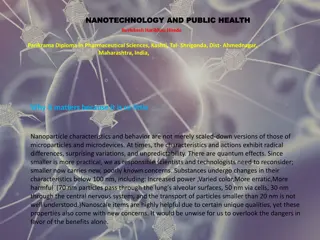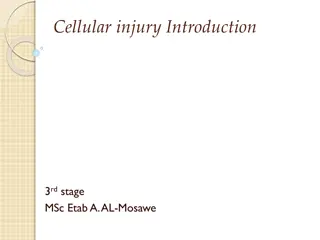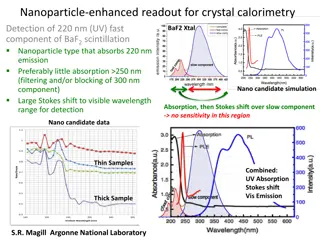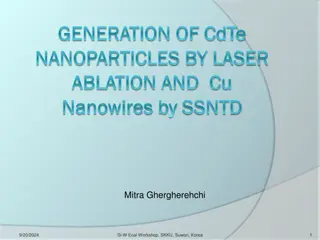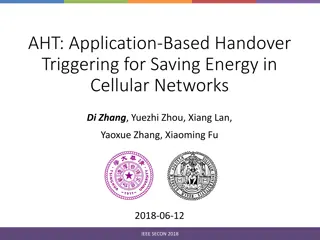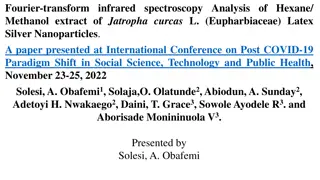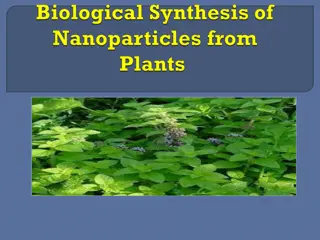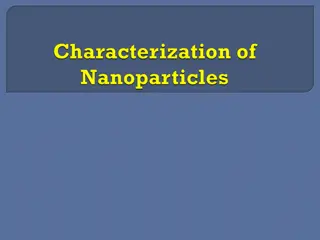Introduction to Liposomes, Niosomes, Nanoparticles: Applications and Cellular Uptake
Liposomes and niosomes are microscopic vesicles utilized for drug delivery, with applications in altering drug distribution at a molecular level. These carriers control drug input into the biological environment for targeted bio-distribution, utilizing lipid molecules and amphiphilic compounds. The cellular uptake, transport across epithelial barriers, extravasation, and lymphatic uptake are key processes facilitated by these nanoparticles. Understanding the structural composition and components of liposomes, such as phospholipids and cholesterol, is crucial for enhancing drug delivery efficacy.
Download Presentation

Please find below an Image/Link to download the presentation.
The content on the website is provided AS IS for your information and personal use only. It may not be sold, licensed, or shared on other websites without obtaining consent from the author.If you encounter any issues during the download, it is possible that the publisher has removed the file from their server.
You are allowed to download the files provided on this website for personal or commercial use, subject to the condition that they are used lawfully. All files are the property of their respective owners.
The content on the website is provided AS IS for your information and personal use only. It may not be sold, licensed, or shared on other websites without obtaining consent from the author.
E N D
Presentation Transcript
Introduction to liposomes, niosomes, nanoparticles, monoclonal antibodies and their applications NDDS- VII sem Dr. Garima Joshi Assistant Professor Pharmacy department, MLSU Udaipur.
Cellular Uptake and Processing Transport across the epithelial barrier Extravasation Lymphatic Uptake
Controlling the distribution of drug by incorporating it in a carrier Altering the structure of the drug at molecular level By controlling the input of the drug into the bio- environment to ensure a programmed and desired bio-distribution.
Liposomes are simple microscopic vesicles in which anaqueous volume is entirely composed by membrane of lipid molecule various amphiphilic molecules have been used to form liposomes. The drug molecules can either be encapsulated in aqueous space or intercalated into the lipid bilayers The extent of location of drug will depend upon its physicochemical characteristics and composition of lipids.
Liposomes are simple microscopic vesicles in which an aqueous volume is entirely enclosed by a membrane composed of lipid molecule. Structurally, Liposomes are concentric bilayered vesicles in which an aqueous volume is entirely enclosed by a membranous lipid bilayers mainly composed of natural or synthetic phospholipids. Liposomes is Greek words means Lipo mean Fat and Somes mean Body . Liposomes were first produced in England in 1961 by Alec D. Bangham.
There are number of components of liposomes however Lecithin (mixture of phospholipids) and cholesterol being main components. 1. Phospholipids are fatty substances the major structural components of cell wall & biological membranes. Phospholipids are amphipathic moieties with a hydrophilic head group and two hydrophobic tails. Two types of phospholipids exist phosphodiglycerides and sphingolipids, together with their corresponding hydrolysis products. Phospholipids have phosphatidyl moiety (tail) with different head groups (choline, Etahnolamine, Serine) The most common phospholipid is phosphatidylcholine (PC) molecule. Phosphatidylcholine has glycerol bridge links a pair of hydrophobic acyl hydrocarbon chains having 10-24 carbon atoms with a hydrophilic polar heads
Cholesterols -Incorporation of sterols in liposome bilayer can bring about major changes in the preparation of these membranes. Cholesterol does not by itself form bilayer structure , it acts as fluidity buffer. It inserts into membrane with hydroxyl group oriented towards aqueous surface & aliphatic chain aligned parallel to acyl chains in the centre of bilayer. It can be incorporated into phospholipid membranes in very high Conc. upto 1:1 or even 2:1 molar ratios of PC. Cholesterol incorporation increases the separation between the choline head groups and eliminates the normal electrostatic and hydrogen-bonding interactions.
In aqueous media phospholipids as they are not soluble align themselves closely in planar bilayer sheets or lipid cakes which is thermodynamically stable. In bilayer sheets polar head groups face outwards into the aqueous medium, the lipidic chains turns inwards to avoid the water phase, giving rise to double layer. For the liposomes to be formed, upon further hydration, the lipid cakes (lamella) swells eventually they curve to form a closed vesicles in the form of spheres These spheres are called as liposomes. Amphiphatic molecules other than PC from micellar structure in preference to bilayer sheet.
On the basis of composition and application 1. CL (Conventional liposomes), 2. Fusogenic liposomes, 3. pH sensitive liposomes, 4. Cationic liposomes, 5. Immuno-liposomes. 6. Long circulatory liposomes (stealth)
Hydrophilic Hydrophobic
These can be categorized on the basis of lipid dispersion. 1. Physical dispersion technique: a) Lipid film hydration by Hand-shaking (MLV), non-hand shaking (LUV) b) High shear homogenization/ Sonication c) Membrane extrusion d) Microfluidizer techniques for Micro emulsification e) French pressure cell f) Dried-reconstituted vesicles g) Fusion method 2. Solvent dispersion technique a) Ethanol Injection b) Ether injection c) Reverse phase evaporation vesicles d) Emulsion & Double emulsion vesicles. 3. Detergent solubilization technique
The liposomes prepared by various techniques are to be evaluated for their physical, chemical as well as biological properties. A)Physical Characterization: 1. Entrapement efficiency 2. Vesicle shape & morphology 3. lamellarity 4. Particle size & size distribution 5. Surface charge 6. Phase transition behaviour 7. Drug release B) Chemical Characterization: 1. Phospholipid concentration 2. Cholesterol concentration 3. Lysolecithin concentration 4. Phospholipid peroxidation 5. Phospholipid hydrolysis & Cholesterol autooxidation 6. pH of liposomal dispersion. 7. Osmolarity C) Biological Characterization: 1. Sterility testing 2. Pyrogenicity testing. 3. Animal toxicity D) Stability testing:
Liposome as drug delivery vehicle 2. Liposome as vaccine carrier 3. Liposome in tumour therapy 4. Liposome in gene delivery. 5. Liposome as artificial blood surrogates 6. Liposome as radio-pharmaceutical & radiodiagnostic carrier 7. Liposome in cosmetics and dermatology 8. Liposome in enzyme immobilization
Niosomes : Niosomes are nonionic surfactant vesicles which can entrap both hydrophilic and lipophilic drugs either in aqueous phase or in vesicular membrane made up of lipid materials It is reported to attain better stability than liposome s. It may prove very useful for targeting the drugs for treating cancer, parasitic, viral and other microbial disease more effectively.
